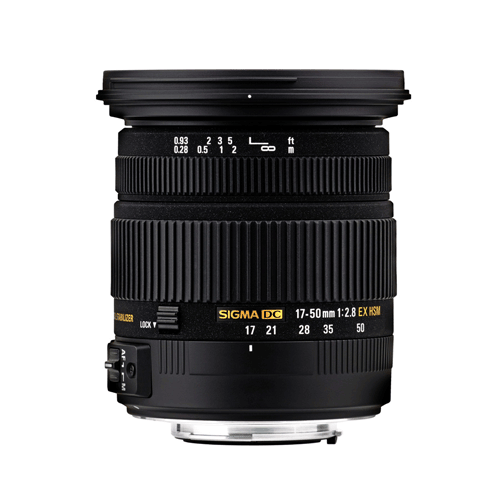Sigma 17-50mm f/2.8 EX DC OS HSM
 |
| Gary Wolstenholme takes a look at Sigma's flagship standard zoom for APS-C digital SLR cameras. |
Sigma's 17-50mm f/2.8 EX DC OS HSM costs around £590 and is available for Sigma, Canon, Nikon, Sony and Pentax SLR cameras that have an APS-C or smaller sized sensor. The lens features a fast maximum aperture of f/2.8 throughout the range, silent focusing and optical stabilisation.
Sigma have a few other lenses within their own line-up that may be suitable alternatives, depending on your requirements. If you need the fast maximum aperture, but can live without the optical stabilisation, then the 18-50mm f/2.8 Macro HSM may be for you. It's cheaper, costing around £320, but isn't as wide. If you require a longer zoom range, and can live without the constant f/2.8 aperture, then the 17-70mm f/2.8-4 DC Macro OS HSM may be for you. This lens is also slightly cheaper, costing around £330 and is a little longer at the telephoto end. Their 18-50mm f/2.8-4.5 DC OS HSM is available for the bargain basement price of around £185, but has a slower maximum aperture, except at 18mm.
Tamron make a couple of lenses that cover this range and also have a fast maximum aperture of f/2.8. Their 17-50 f/2.8 XR Di II VC lens has vibration compensation, but lacks a silent focusing motor and costs around £390. They also do a 17-50 f/2.8 XR Di II LD model without vibration compensation which costs around £327.
Tokina's 16-50mm f/2.8 is one millimetre wider at the short end and also sports a fast maximum aperture through the range, but lack optical stabilisation and a silent focusing motor. This lens can be picked up for around £600.
Canon users also have the choice of their EF-S 17-55mm f/2.8 IS USM lens, which costs around £700 and adds full time manual focus override and an extra 5mm at the telephoto end to the specification of the Sigma.
Nikon's 17-55mm f/2.8 also adds 5mm to the long end and adds professional weather sealed build quality, but lack vibration reduction. It does cost around £1040 though, so it's quite a pricey choice.
Sony don't currently make a fast zoom for their APS-C cameras, so Sony Alpha users may pay special attention to offerings from third party manufacturers such as Sigma and Tamron.
Pentax users have access to their 16-50mm f/2.8 DA* ED lens, which also has a fast constant f/2.8 aperture, silent focusing and is one millimetre shorter at the wide end. It costs around £695, but doesn't have image stabilisation, which many Pentax users won't miss, as their cameras have that feature built in.
Sigma 17-50mm f/2.8 EX DC OS HSM: Handling and features
At only 92mm long, this lens is very compact for one with an f/2.8 constant maximum aperture. It's quite lightweight too, weighing only 595g. Still the build quality is reassuringly sturdy. Although it may not be up to the standard of the top marque lenses, the plastics used in the construction feel strong enough to withstand reasonably heavy use. Mechanically the lens is well put together too, with no creaks or wobbles anywhere. The zoom mechanism is smooth and doesn't tighten up at any point in the range.
The zoom ring has a notched rubber coating, which provides a decent grip and is positioned just right so that the palm of your hand can rest on the base of the camera. Focusing is powered by a silent HSM type motor, which focuses smoothly and quickly in good conditions. I did notice it would tend to hunt around for focus a little when attempting to lock onto a subject in poor lighting conditions, so it may be worth ensuring your focus assist illuminator is enabled when the light levels drop. During focusing the focus ring moves back and forth, and there is no way of disengaging it. In use I found I would often catch my fingers on it as it moved, so care may need to be taken as you adjust to the lens.
The lens accepts 77mm filters and as focus is performed internally, the filter thread does not rotate. This should please users of polarisers and neutral density graduated filters.
Sigma's Optical Stabilisation system promises to allow for sharp shots to be taken at shutter speeds up to four stops slower than without the system. In use I managed to achieve sharp shots most of the time at shutter speeds as low as 1/10sec at 50mm. Although this is only three stops slower than the usual rule of thumb would recommend, it's still pretty useful.
Sigma 17-50mm f/2.8 EX DC OS HSM: Performance
Although this lens certainly isn't a poor performer, it failed to produce outstanding results during testing. At 17mm the resolution in the centre at f/2.8 is approaching good, and the edges are fair. Stopping down improves matters, but the quality towards the edges never really reaches what I would call good levels at this focal length. Peak image quality across the frame is achieved at f/11, where the resolution in the centre is very good, but the edges still lag behind somewhat.
At 28mm the performance in the centre improves at every aperture, exceeding excellent levels at f/5.6. Unfortunately the same can't be said about the quality towards the edges. At maximum aperture the edges of the frame are sub-par and don't really improve noticeably until f/8.
Finally at 50mm the quality towards the edges starts to catch up to that in the centre. At f/2.8 the centre sharpness is good and the edges are fair. Here peak quality across the frame is achieved at f/5.6, where the centre resolution is excellent and the quality towards the edges is good.
Overall I'm a little disappointed by the lacklustre performance towards the edges at maximum aperture. After all, why would you use a lens with a bright aperture if you knew it needed to be stopped down? At least the performance in the centre is good for the most part.
Chromatic aberrations are kept well within acceptable levels throughout the zoom range. At their worst they cover an area of 0.68 pixel widths at 50mm and f/2.8 towards the edges, which should only really show on very large prints, if you go looking for it.
Falloff of illumination is noticeable, but not overly strong for a lens with an f/2.8 aperture. At 17mm and f/2.8 the corners are 1.82stops darker than the image centre. Here, stopping down to f/5.6 results in visually uniform illumination. At 50mm the level of vignetting has decreased a little but is still at a fairly noticeable level. Here the corners are 1.22 stops darker than the image centre and stopping down to f/5.6 results in visually uniform images.
Barrel distortion is pretty prominent at 17mm. Here Imatest recorded a level of 5.27% barrelling, which could pose problems, especially if straight lines are important. At 50mm, barrel distortion is replaced with a mild level of 0.113% pincushion distortion. The distortion pattern thoughout the zoom is uniform, so should be easy to correct in image editing software afterwards.
| Click on the thumbnails for a high resolution image. | ||
 |  | |
| At 17mm the centre resolution is good. | The lens tends to perform better at 50mm, producing images with excellent sharness in the centre. | |
Flare is kept to reasonable levels, only becoming an issue in extreme circumstances. Shooting directly into the light will normally result an a noticeable loss of contrast more than anything else. A decent sized petal-shaped lens hood comes supplied with the lens, which does an excellent job of keeping unwanted light off the front element, reducing the chances that light from outside the frame will cause issues with flare.
Sigma 17-50mm f/2.8 EX DC OS HSM: Verdict
On paper this lens look like a winner. The specification for the price is very good indeed. Although the resolution in the centre is usually good, the same cannot be said about the quality towards the edges, especially at wide apertures.
Saying that the build quality is good, the optical stabiliser works quite well and the lens is capable of excellent results if used within its limits. If you can't compromise to stay within those limits, you may find better value with an alternative lens.
Sigma 17-50mm f/2.8 EX DC OS HSM: Pros
 Excellent performance in the centre between 28 and 50mm when stopped down
Excellent performance in the centre between 28 and 50mm when stopped down Effective Optical Stabiliser
Effective Optical Stabiliser Compact and lightweight for an f/2.8 zoom
Compact and lightweight for an f/2.8 zoomSigma 17-50mm f/2.8-4 DC Macro OS HSM: Cons
 Lens really needs stopping down for best results
Lens really needs stopping down for best results Sharpness towards the edges,
Sharpness towards the edges,  Focus ring cannot be disengaged
Focus ring cannot be disengaged| FEATURES |  |
| HANDLING |  |
| PERFORMANCE |  |
| VALUE FOR MONEY |  |
| OVERALL |  |
Sigma 17-50mm f/2.8 EX DC OS HSM: Lens specification
| Price | £590.00 |
| Contact | www.sigma-imaging-uk.com |
| Filter size | 77mm |
| Format | APS-C |
| Construction | 17 elements in 13 groups |
| Angle-of-view | 72.4 - 27.9 degrees |
| 35mm equivalent focal length (on APS-C body) | 25.5-75mm |
| Internal focusing | Yes |
| Image stabilisation | Yes |
| Minimum focus | 28cm |
| Maximum aperture | f/2.8 |
| Minimum aperture | f/22 |
| Weight | 565g |
| Size | 83.5mm x 92mm |
| In the box | Lens Case, Lens Hood |
The Sigma 17-50mm f/2.8 EX DC OS HSM costs around £590 and is available from Warehouse Express here:
Sigma 17-50mm f/2.8 EX DC OS HSM for Canon
Sigma 17-50mm f/2.8 EX DC OS HSM for Nikon
Sigma 17-50mm f/2.8 EX DC OS HSM for Sony
Sigma 17-50mm f/2.8 EX DC OS HSM for Pentax
Sigma 17-50mm f/2.8 EX DC OS HSM for Sigma
Add your message
Login required
Please login here or if you've not registered, you can register here. Registering is safe, quick and free.
Please login here or if you've not registered, you can register here. Registering is safe, quick and free.
photodo Stats
1102 lenses
428 MTF tests
74 in-depth photodo reviews
100+ users join each day
Help the lens community by reviewing or rating a lens today via our lens search
428 MTF tests
74 in-depth photodo reviews
100+ users join each day
Help the lens community by reviewing or rating a lens today via our lens search
Latest Lens Reviews
- Chinon 28mm f/2.8 Vintage Lens Review
- Canon EF 70-200mm f/4L IS II USM Lens Review
- Samyang AF 85mm f/1.4 EF Review
- Sigma 70mm f/2.8 DG Macro Art Review
- Samyang AF 24mm f/2.8 FE Review
- Meike 50mm f/1.7 Review
- Tamron 70-210mm f/4 Di VC USD Review
- Lensbaby Burnside 35mm f/2.8 Review
- Asahi Super Takumar 50mm f/1.4 Review
- Asahi Super-Multi-Coated Takumar 135mm f/3.5 Review






